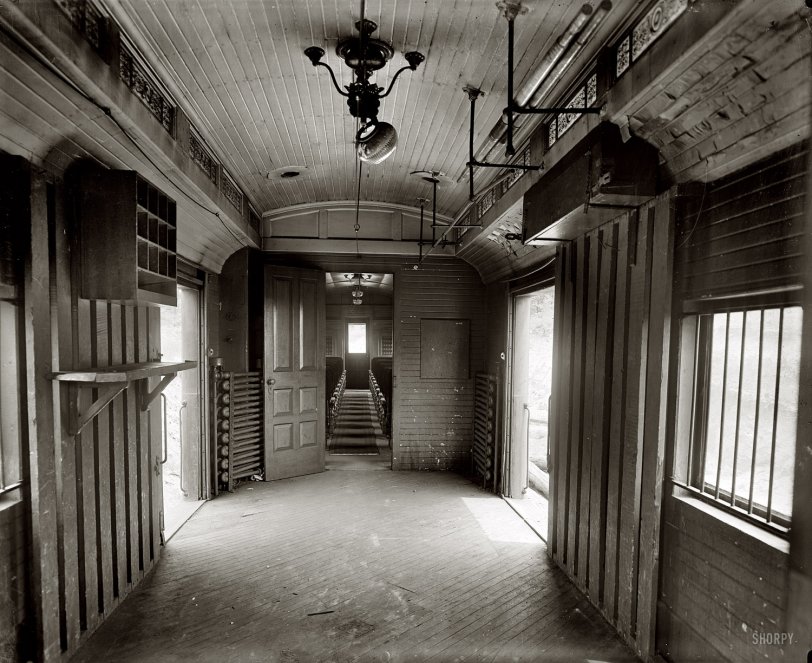


Framed or unframed, desk size to sofa size, printed by us in Arizona and Alabama since 2007. Explore now.
Shorpy is funded by you. Patreon contributors get an ad-free experience.
Learn more.

- Ticket Retention
- Killed by Amtrak
- Back to the Future
- Heckuva remote control!
- Sometimes — Things Go Bump!
- I SEE THE LIGHT
- Union Switch and Signal Company
- Get That Light Out Of My Eyes
- Eggs. Eggs. Eggs. The Egg Man is Here!
- Foreboding caption
- Famous Hollywood faces
- Not just S&P
- re: Those things in the jar
- Up In Smoke
- Medical Smoking
- Quick fix
- A Quink Comment
- If You’re Like Me, Never
- Delivering the News
- U.S.A.
- S&P
- 1940 Zenith radio model 6G601
- Quality goes in before the name goes on!
- Snazzy skirt
- Carbon Arc Lamps
- Illuminate us
- I remember it well
- I can't prove it
- Complicated then, forgotten now
- Bryan-Stevenson
Print Emporium
All Aboard: 1930

"Car interior. Washington & Old Dominion R.R." Another circa 1930 view of a decrepit Pennsylvania Railroad car that seems to have come into the possession of the W. & O.D. Harris & Ewing Collection glass negative. View full size.
Classic Combine
This car is properly referred to as a "combine" since it combines two cars in one; baggage/express and coach seating.
Judging from the rough track and the rural locale, it may have been working out its last years as a "miner's car," downgraded to commuter service where dirty clothes were a fact of life.
If it ever carried mail, the equipment shown here is strictly non-regulation. Before WWI, postal regulations required a separate, enclosed area, known as the "apartment," usually 10 or 15 feet long on cars of this type, fitted with very specific sorting, storage and handling equipment. In the exterior shot of the car, there is no lettering for U.S. Mail (also required by regulations) or Express service. I'm inclined to think the pigeonholes may be a waybill box and a small desk for the conductor, and the car was being used in freight or mixed train (freight and passenger together) service.
The steam radiators operate only when the car is connected to a passenger service locomotive and/or other passenger cars equipped with steam lines. In the shot of the entire car, note the large round device at the rear, mounted on the side of the roof. This is an exhaust for a separate car heater, so it could be run in freight or mixed train service and still be warm.
As for lighting, the car has roof vents for gaslights. Again, in the shot of the entire car, note the large cylindrical tank at the lower center, which was actually a gas storage tank for manufactured or "town gas" like that used in cities. This was much safer and quickly replaced kerosene lamps.
It galloped
This photo puts me in mind of a railroad oddment we used to see often in the Midwest up through the 1950s. It was a motorized rail car that was half cargo and half passenger. It ran between rural communities and metro areas, similar to an interurban, but on the mainline railroads, such as the Chicago & Northwestern. The nickname: The Galloping Goose!
Heating
It appears to have had two wood burning stoves at one time. I guess the steam heaters where added later. It's funny to see that this car was old and worn out by the thirties. All wooden cars are pretty rare these days.
Nice door...
There's a nice six-panel solid core door that I wouldn't mind having.
They don't make'em like that anymore.
I would love to have that light fixture in my possession! I keep looking at how precariously the glass globe is perched on that fixture and wishing somehow I could save it!
Please Exit By Rear Platform
This is a "Petticoat Junction" style mail-freight-passenger coach, but it has about ten more passenger seats and is about twelve feet longer. Otherwise, it's much the same.
From the left in the photo, there's a mail sorting desk, the freight door, and a steam radiator to keep the crew warm on those long winter night runs.
Then a heavy wooden door, and a view back through the passenger compartment. The ceiling is a clerestory roof with side vents, which would have allowed a little fresh air into the car on hot days.
On the right, we see another radiator, and another freight door. Which was important, because the train crew could never be sure which side they'd have to unload the luggage and freight from in back then.
The lamp (with its shade falling off) was probably a kerosene lamp. Something of a fire hazard, especially in a wooden car. But this one went all the way to the
end of the line... where it was left to rot away.
























On Shorpy:
Today’s Top 5